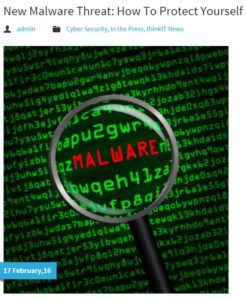This Notice is to inform you about a new malware threat, which is spreading at an alarming rate. This exploit is being transmitted via email, so we’re urging our friends to be sure to only open attachments that you are expecting, and ones that are from a reputable source. If you have any problems or anomalies, please contact thinkIT Solutions immediately. Remember, you can find software that can protect your computer from malware online, or you can check out this peerblock download link.
This new malware campaign spreading “Locky” or “Locky Files” is a type of ransomware-a type of Trojan malware that locks your computer files and demands money to unlock them. This sort of thing happens to businesses and individuals more often than some people might think. To prevent this from happening, this IT support St Albans company, for example, could be contacted to implement some cybersecurity solutions onto computers to deter malware. If anyone has already been affected by malware, it’s important to learn more about it before responding. This article contains all the details on the Locky outbreak. Here are the three things you need to know:
1.How Do You Get Infected?The Locky ransomware is exclusively spread via email attachments that look like Microsoft Word Documents. As a rule, the email in question will have a subject line that looks similar to “ATTN: Invoice J-11256978” and will include an attached Word document with a title similar to “invoice_J-11256978.doc”
Below is a screen shot of an actual email containing the malware.
2. What Should You Do to Prevent This Infection?
Be on a strong lookout for phishing emails suggesting to take action by opening an attachment in your email, especially if it is an email from someone you do not know.
3. Actions to take if you believe you have opened a file you were not supposed to:
- DISCONNECT YOUR COMPUTER FROM INTERNET – IMMEDIATELY!
- Desktops – unplug the Ethernet cable from the back of your workstation.
- Laptops – use the hardware WiFi on/off switch on the side of your laptop or disconnect from the network using the WiFi icon at bottom right of your screen.
- DO NOT POWER DOWN YOUR COMPUTER!
- Powering down your computer and letting it reboot causes the ransomware to get further into your computer.
Call Jason Canon with thinkIT @ 720-979-1820 or call our office at 720-307-3450 for assistance as soon as possible.





0 Comments